Abstract
High indoor air quality is crucial for the health of human beings. The purpose of this work is to analyze the synergistic effect of particulate matter 2.5 (PM2.5) and carbon dioxide (CO2) concentration on occupant satisfaction and work productivity. This study carried out a real-scale experiments in a meeting room with exposures of up to one hour. Indoor environment parameters, including air temperature, relative humidity, illuminance, and noise level, were controlled at a reasonable level. Twenty-nine young participants were participated in the experiments. Four mental tasks were conducted to quantitatively evaluate the work productivity of occupants and a questionnaire was used to access participants’ satisfaction. The Spearman correlation analysis and two-way analysis of variance were applied. It was found that the overall performance declined by 1% for every 10 μg/m3 increase in PM2.5 concentration. Moreover, for every 10% increase in dissatisfaction with air quality, productivity performance decreased by 1.1% or more. It should be noted that a high CO2 concentration (800 ppm) has a stronger negative effect on occupant satisfaction towards air quality than PM2.5 concentration in a non-ventilated room. In order to obtain optimal occupant satisfaction and work productivity, low concentrations of PM2.5 (<50 μg/m3) and CO2 (<700 ppm) are recommended.
1. Introduction
People spend more than 80% of their time in enclosed buildings [1,2]. Hence, the indoor air quality has a great influence on occupants’ feelings, health, and work productivity. Existing studies suggest that investments in improvements of the indoor environment, especially the indoor air quality, could be financially feasible [3,4]. In order to improve the occupant satisfaction and work productivity, it is important to understand how the indoor environment affects them.
Most of existing studies focus on investigating the impact of temperature on building occupants. Wyon (1996) concluded that individual control of the air temperature helps to reduce the risk of sick building syndrome (SBS) and improve work productivity [5]. Toftum et al. (2002) showed that a decrease in air temperature from 23 °C to 18 °C provides better satisfaction towards air quality. In the meantime, it has no significant influence on the risk of sick building syndrome (SBS) for a short time [6]. Seppänen et al. (2006) found that work productivity at 30 °C is 91% of that at 22 °C [7]. Wong et al. (2008) proposed a series of logistic models, which are based on data from 293 occupants, to predict the acceptance of indoor environment quality in offices. In those models, operative temperature, CO2 concentration, the noise level, and the illumination level are included [8]. Experiments in Lan et al. (2011) indicated that a bit below thermal neutral leads to maximum performance and thermal discomfort causes lower performance [9]. In contrast, Wang et al. (2018) showed that the best performance is obtained when participants are under slightly warmer conditions [10]. Geng et al. (2017) established a quantitative relationship between work productivity and thermal environment to predict the relative work productivity according to the background air temperature. It shows that the highest thermal satisfaction is obtained at about 25 °C [11].
However, the air temperature is not the only influencing factor. The indoor air quality can also exert significant influences on the satisfaction and work productivity of occupants. The ventilation rate as well as the indoor and outdoor air pollutant levels are three dominant physical parameters in studies on the indoor air quality [12]. The main air pollutants include particulate matter 2.5 (PM2.5), carbon monoxide (CO), carbon dioxide (CO2), and the volatile organic compound (VOC). Among them, PM2.5 is “fine particles” with an aerodynamic diameter less than or equal to 2.5 microns (μm) [13].
In the past two decades, the economy has grown rapidly in China, while it has also been accompanied by serious air pollution. More and more attention is being given to the air quality, especially the PM2.5 level, since PM2.5 is one of the most important indexes to evaluate air quality. The ratio of the indoor to the outdoor PM2.5 concentrations (Indoor/Outdoor ratio) is a commonly used indicator to evaluate the indoor PM2.5 pollution [14,15,16,17].
Another indicator, CO2 concentration, is also often used to quantify the indoor air quality and ventilation [18]. The CO2 concentration in a room can be predicted based on the age and activity level of occupants. According to an IPCC (Intergovernmental Panel on Climate Change) report (2015), the concentration of CO2 in the atmospheric boundary layer is close to 400 ppm [19]. The American Society of Heating, Refrigerating and Air-Conditioning Engineers (ASHRAE) set 1000 ppm as a guideline value for CO2, based on a ventilation rate of 15 cfm/p and an outdoor CO2 concentration of 300 ppm [20]. It is worth mentioning that the CO2 level of 1000 ppm is a guideline for comfort acceptability rather than a mandatory requirement for indoor air quality [21].
Wargocki et al. (1999) suggested that indoor air pollution may reduce the performance of occupants [22]. Since then, the impact of indoor air quality on work performance has attracted the attention of many scholars. Wargocki (2000) confirmed that indoor air quality affects work productivity. Every 10% improvement of occupant dissatisfaction towards air quality helps to increase work productivity by 1.5% [23]. Based on a series of experiments, Wyon (2004) concluded that bad indoor air quality leads to a reduction of office performance of 6–9% [24]. Mui et al. (2009) reported that formaldehyde (HCHO) exposure risk increases by 2.5% for every 10-ppm increment, when the background CO2 concentration ranges from 800 to 1000 ppm [25]. Satish et al. (2012) found that more than half of subjects appear to reduce decision-making performance at CO2 concentrations of 1000 ppm, relative to 600 ppm [26]. Vehviläinen (2016) showed that higher CO2 concentrations reduce functional abilities [27]. Allen et al. (2016) found that cognitive performance is much better in green buildings than in conventional buildings and that high concentrations of VOCs and CO2 have a negative impact on work productivity [28].
Most of these previous studies only provide qualitative results, and hence it is difficult to provide a quantitative guideline on the control of indoor air quality. Also, the probable synergistic effect of PM2.5 and CO2 concentration still lacks investigations. Therefore, comprehensive studies considering the influences of air quality on occupant satisfaction and work productivity are badly needed.
The purposes of this study are:
- To evaluate the probable synergistic effect of CO2 and PM2.5 concentrations on occupant satisfaction towards air quality and work productivity.
- To provide guidance on how to improve occupant satisfaction and work productivity by controlling the indoor environment.
In order to achieve these purposes, therefore, a real-scale experiment with background conditions being carefully controlled was carried out. The collected data was tested by the Shapiro–Wilk method to determine the normal distribution. In addition, the relationship between the satisfaction and environmental parameters was considered and also the relationship between air quality dissatisfaction and performance changes. Besides, the results of the impact of PM2.5 and CO2 on occupants’ satisfaction and work productivity were demonstrated.
2. Methodology
This study focuses on the impact of the PM2.5 concentrations on the occupants. Both the PM2.5 and CO2 concentrations were involved dur to the synergistic effect produced by the CO2 concentration. The detailed experiment setup and procedures are described in this section.
2.1. Experiment Setup
A meeting room in an office building was used for carrying out the experiments. The layout of this room is 4.85 m by 4.80 m, which is shown in Figure 1.
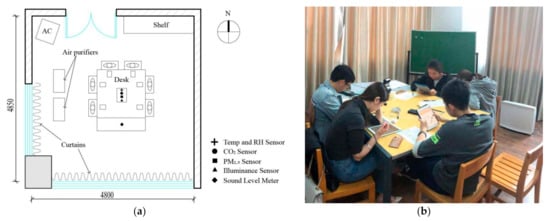
Figure 1.
(a) Layout of the simulated meeting room; (b) Photo during the experiment.
The indoor environmental conditions were controlled as follows during the experiments. Windows and curtains were closed during the tests. The indoor temperature was controlled at around 24 °C to 26 °C by an air conditioner, with a relative humidity range of 40–60%. In this temperature and relative humidity set up, the occupants’ thermal dissatisfaction is at its lowest level [11]. Based on the standard for the lighting design of buildings [29], the illuminance on the desk was adjusted to 300 lux. In addition, the A-weighted sound pressure level was maintained at around 40 dB. The thermal, light, and acoustic conditions of the room were similar to common offices.
Before each experiment, when the outdoor PM2.5 reached the experimental target, the windows were opened to provide adequate natural ventilation to ensure the indoor PM2.5 and CO2 concentrations were similar to those of the outdoor environment. Then, the windows were closed and the indoor air circulation in the indoor environment was purified by two air purifiers (Air-O-Swiss P380 Plaston Group, Widnau, Switzerland). Five different levels of the intended PM2.5 concentrations (10, 25, 35, 50, 75 μg/m3) were selected. A series of preliminary experiments were conducted, showing that the PM2.5 concentration can be controlled within plus or minus 15% of the set value for up to one hour, when the indoor PM2.5 concentration is higher than 10 μg/m3. The limit values of PM2.5 concentrations were set with reference to WHO guidelines [30] and the air quality standards in China [31]. After the air was decontaminated by the particulate air purifiers, the measured PM2.5 concentration values typically reached the set point within one hour and remained at this value throughout the experiments. The indoor CO2 concentration level was gradually increased from approximately 500–900 ppm as the participants exhaled.
All relevant indoor environmental factors, as well as CO2 and PM2.5 factors, were monitored and recorded by the instruments at the center of the desk. Positions of those instruments are marked in Figure 1. Detailed information of instrument, including model types, and accuracies, are listed in Table 1. The accuracy of the PM2.5 nephelometer has been verified by comparing the measurement results from a DustTrak II aerosol monitor [TSI-8530, TSI Incorporated, Shoreview, MN, USA]. The calibrations were also performed at different temperatures and humidity, and different PM2.5 concentrations, and the results were found using the weighting method to adjust the measurement of Nephelometers. In addition, the particle count concentration monitoring was used, while three other offices were selected next door for validation. Two condensation particle counters (TSI CPC3007, TSI Incorporated, Shoreview, MN, USA) with a large concentration of particles larger than 0.01 μm in diameter and an accuracy of ±20% were used. The particle number concentration measurements were considered to be accurate at up to 100,000 cm3) were measured simultaneously and the results were similar. This calibration method has been recognized by other studies [32]. Besides, the outdoor air temperature, relative humidity, CO2 concentration, and PM2.5 was measured outside the building and the instruments were protected from direct sunlight, rainfall, pedestrians, traffic, and factors that would affect the accuracy of the data.

Table 1.
Measuring parameters and instruments.
2.2. Participants and Experiment Procedure
Twenty-nine volunteers, 11 males and 18 females, were recruited in Zhejiang University. All participants are students of Zhejiang University. The Information on gender, age, height, weight, and body mass index (BMI) was collected, as summarized in Table 2. The BMI was calculated from weight and height [weight (kg)/height (m2)] [33]. For adults over 20 years old, normal BMI ranges from 18.5 to 24.9 kg/m2 [34]. The sample size of volunteers was referenced from previous studies in simulated environments, as shown in Table 3.

Table 2.
Background characteristics for the 29 participants.

Table 3.
Comparison of sample sizes in different studies.
Five or six participants were randomly assigned to each of the five experimental groups. All participants were healthy and in a good mental state during the tests. They were all briefed on the experiment procedure before each test. During the test, they were allowed to adjust their clothes as they like and they had 15 min of adaptive time [10,11].
The experiments were carried out from 8 to 24 November 2018. The outdoor air temperature during the experiments was around 11–17 °C relative humidity was 40–90%, and CO2 concentration was 400–500 ppm, while the outdoor PM2.5 concentration during experiments is shown in Figure 2.
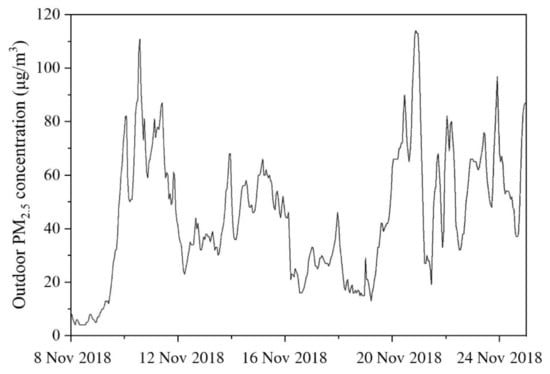
Figure 2.
Outdoor PM2.5 concentration during experiments.
Each experiment included three parts: a questionnaire survey, productivity test and palm temperature test, which is illustrated in Figure 3. Each productivity test consisted of four productivity tasks. Indoor environment parameters were recorded during the experiment. Palm temperature was used to determine the temperament of participants [36].
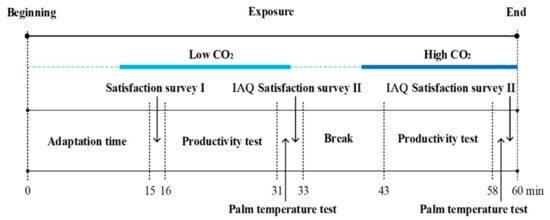
Figure 3.
The procedure of each experiment. Note: The timeline is not consistent with the actual time.
Each group of participants was subjected to five experimental conditions with five levels of PM2.5 concentrations (10, 25, 35, 50, 75 μg/m3). The sequence of the experimental conditions was determined. In order to eliminate the potential influences of group number and scenario order, the Latin-square design was used, as shown in Table 4. The procedure of each experiment (m = 1,2,…,5) included four stages: adaptation, a productivity test with low CO2 concentration(SmL) conditions, a break, and a productivity test with high CO2 concentration(SmH) conditions. The adaption time was set to 15 min after the participants entered the testing room. As there was a negligible difference between the indoor and the outdoor environment, both of the productivity tests lasted for 15 min and with a 10 min break. At the end of the adaptation, a satisfaction questionnaire survey of the indoor environment was carried out to rule out discomfort regarding the environmental factors. After each productivity test, the palm temperature of each participant was recorded by an infrared thermometer (MT4 max, Fluke corporation, Everett, WA, USA) [36], and the IAQ (Indoor Air Quality) satisfaction questionnaire survey was conducted. The experiments followed a single-blind process, where the experimental conditions were unknown to the participants.

Table 4.
Latin-square design for the experiment.
The satisfaction questionnaire survey (Appendix A) consists of Environmental satisfaction and IAQ satisfaction. The participants’ satisfaction has different factors, including indoor and outdoor air quality, temperature, relative humidity, lighting, acoustics, and overall environment. Satisfaction was rated on a 7-point scale ranging from “very satisfied (+3)” to “very dissatisfied (−3)”, with a neutral midpoint (0) [37]. Votes of −3 to −1 were classified as air quality dissatisfaction, and the percentages of dissatisfaction were calculated separately. The IAQ Questionnaires survey was recorded twice, considering the low and high CO2 concentrations.
The productivity test consisted of four tasks: “Recognition of Figures”, “Stroop Color and Word”, “Rule-based Reasoning”, and “Schulte Grid 7 × 7” (Table 5). They are used to measure different aspects of work productivity, including understanding and memory, perception, logical thinking, and visual attention [38].

Table 5.
Detailed recorded parameters for four tasks.
Recognition of Figures is used to measure the ability of understanding and memory [39]. Twenty-four pages with up to 10 patterns appear in a sequential order. Participants need to find a pattern that has never appeared before. Only one chance is given in each page. Up to three mistakes are allowed in each task. Participants get 200 points for each page passed, and the scores are calculated automatically.
- ●
- The Stroop Color and Word is a neuropsychological test used to assess the perception ability [40]. Two words are displayed on the screen at the same time. The words name a color that is not the same as the ink color of the word; for example, the word “blue” is displayed in red ink. Participants need to determine if the color described by the first word is the same as the ink color in which the second word is displayed. Participants have 45 s in each task. They get 50 points for each correct answer, and a 50 points penalty for each wrong answer.
- ●
- Rule-based Reasoning is used to evaluate logical thinking ability [41]. There are five groups of geometric patterns in different colors. Each group has 10 patterns, which have a common color or shape characteristic. Participants need to determine whether each pattern conforms to a certain rule through trial and error. Participants get 50 points for each correct answer, and no penalty for a wrong answer.
- ●
- The Schulte Grid was developed originally as a psycho-diagnostic test to study the properties of attention by German psychiatrist and psychotherapist Walter Schulte [42]. It was used to evaluate the visual attention in this study [43]. At the beginning, the screen displayed a 7 × 7 grid table with 49 randomly distributed numbers. Participants touched a sequential series of numbers in ascending values as quickly as possible. At the end of task, the actual finish time was calculated and recorded automatically. The reciprocal of finish time was used to represent the performance of visual attention.
The detailed tested parameters for four tasks are summarized in Table 5. All participants performed four tasks on an iPad. After the test, the scores and finish times were automatically calculated and recorded by the predetermined program. To encourage all participants to try their best, the higher score was associated with a better bonus.
2.3. Statistical Analysis Methods
The recorded data of the satisfaction of the participants regarding the indoor environment and performance data in the productivity test were both analyzed with SPSS [SPSS.20, IBM Corporation, New York, NY, USA]. The Shapiro–Wilk test was first used to check whether the satisfaction and performance data were normally distributed [44]. The Spearman correlation analyses between the satisfaction vote and indoor environment parameters were carried out to evaluate the degree of correlation. Afterwards, a two-way analysis of variance (two-way ANOVA) was adopted to compare the satisfaction vote and performance of productivity results under each experiment conditions. The significance level of these tests was set as 0.05. The results are statistically significant if the p-value (p) is less than 0.05. The effect size (ES) was calculated to explain the sizes of differences between each group. It indicates whether the difference is practically important [45]. In this study, partial eta squared, denoted as partial η2, was used to represent the ES. Partial η2 is a proportion of variance accounted for by some effect. Partial η2 of 0.01, 0.06, and 0.14 for two-way ANOVA indicate the small, moderate, and large effect sizes (ES) [46].
The palm temperature of the participants was expected to be stable, which indicates that their mental state is stable. The palm temperatures are standardized with Equation (1) to compare the average value of each subject in different conditions:
where is the palm temperature of participant i in experimental condition j, n is the number of experimental conditions for each subject (j = 2 m−1 for low CO2 concentration, j = 2 m for high CO2 concentration), and is the standardized value of participants’ palm temperature i in the experimental condition j. Based on this premise, the following indicators were applied to illustrate the satisfaction and productivity levels of participants at different PM2.5 concentrations.
- Dissatisfaction rate (Rdis) and mean satisfaction vote .
The votes record for both environment and IAQ were classified as dissatisfaction when the vote record was very dissatisfied, dissatisfied, or slightly dissatisfied. The dissatisfaction rate as a percentage of all votes cast is the dissatisfaction rate (Rdis).
The votes ranging from very dissatisfied to very satisfied were assigned from −3 to +3 with the neutral point 0. The mean vale of the satisfaction votes () indicated the satisfaction degree of the occupants in each experimental condition.
- Standardized score and relative performance
The scores of each productivity task were standardized with Equation (2) to compare the average value of each subject in different conditions:
where is the scores or the reciprocals of finish times for participant i in experimental condition j, n is the number of experimental conditions for each participant, and is the standardized value of participant i in experimental condition j.
The relative performance (RP) is the average value of standardized scores of the four tasks, which was used to evaluate the overall work productivity:
where is the standardized performance of subject i in experimental condition j, k is the number of tasks, and is the relative performance of participant i in experimental condition j.
3. Influence of PM2.5 and CO2 on Occupants’ Satisfaction
3.1. Measured Indoor Environment Parameters
Under the conditions of natural ventilation, the indoor CO2 concentration ranges from 500 ppm to 600 ppm. Also, the indoor PM2.5 concentration is the same as the outdoor PM2.5 concentration. Table 6 shows the measured indoor environment parameters of five design scenarios. The PM2.5 concentration in each test was controlled within plus or minus 15% of the designed value. Curtains were always closed to block direct sunlight. The air temperatures of five design scenarios were kept at about 25 °C. CO2 concentration started at about 600 ppm and ended at 800–900 ppm in each experiment. The illuminance on the desk was controlled at about 300 lux. The A-weighting sound pressure was 38–43 dB.

Table 6.
Measured indoor environment parameter at the center of the desk.
3.2. Satisfaction Votes with Different PM2.5 Concentrations
According to Equation (1), the standardized value of palm temperature was calculated, as shown in Table 7. It can be found that there is no significant difference in palm temperature under different PM2.5 and CO2 concentrations (p > 0.05). The standard deviations are all equal or below 3%. The mental states of participants were generally consistent through the experiment. The satisfaction results in Figure 4 suggest that there is no significant correlation between PM2.5 concentration and the satisfaction vote of air temperature, relative humidity, acoustics, and lighting environment. Less than 30% were dissatisfied with the air temperature, relative humidity, lighting, and acoustic environment. This means that most participants were satisfied with the indoor air temperature, relative humidity, lighting, and acoustics.

Table 7.
Standardized results of palm temperature; effect sizes (ES) of 0.01, 0.06, and 0.14 indicate small, moderate, and large effects.
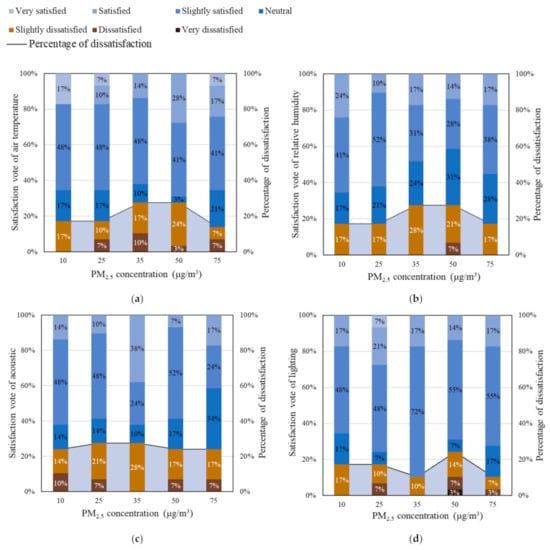
Figure 4.
Distribution of Satisfaction vote and percentage of dissatisfaction of indoor environmental factors.
The satisfaction votes results for indoor air quality under different PM2.5 concentrations are illustrated in Figure 5. The percentage of dissatisfaction can be evidently correlated to the PM2.5 concentration. At the lowest PM2.5 concentration (10 μg/m3), the IAQ dissatisfied rate (Rdis) was only 14% and 17% for the low and the high CO2 concentrations, respectively. It increased gradually with the increase in the PM2.5 concentration, reaching up to 50% and 83% for low CO2 and high CO2, when the PM2.5 was at 75 μg/m3. Along with the PM2.5 concentration, the high CO2 concentrations also contributed to the increase in the dissatisfied rate. When the CO2 concentrations were within the range of 550–700 ppm, each 1 μg/m3 increment in the PM2.5 concentration increased the IAQ dissatisfied rate by 0.5%. The CO2 concentrations were within the range of 750–950 ppm, while the IAQ dissatisfied rate increased by 1.1% per unit of the PM2.5 concentration. Based on the Spearman correlation analysis, the correlation coefficient between satisfaction vote of air quality and PM2.5 concentration was −0.26 (p < 0.05), and that between the satisfaction vote of air quality and CO2 concentration was −0.29 (p < 0.05). It can be concluded that satisfaction vote of air quality is affected by both PM2.5 and CO2 concentrations.
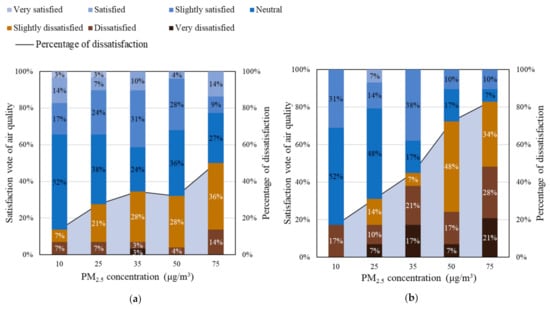
Figure 5.
Distribution of satisfaction vote and percentage of dissatisfaction on air quality under different CO2 concentration:
The dissatisfaction caused by high PM2.5 concentrations also contributes to the decline in occupants’ satisfaction with the overall indoor environment (Figure 6). When the PM2.5 concentration rose from 10 to 75 μg/m3, the overall indoor environmental dissatisfaction rate increased from 17% to 41%. According to Figure 5, each 1% increment in the indoor air quality dissatisfaction would result in a 0.5% rise in the overall environment dissatisfied rate. The PM2.5 concentration has a remarkable impact on satisfaction vote towards the overall environment.
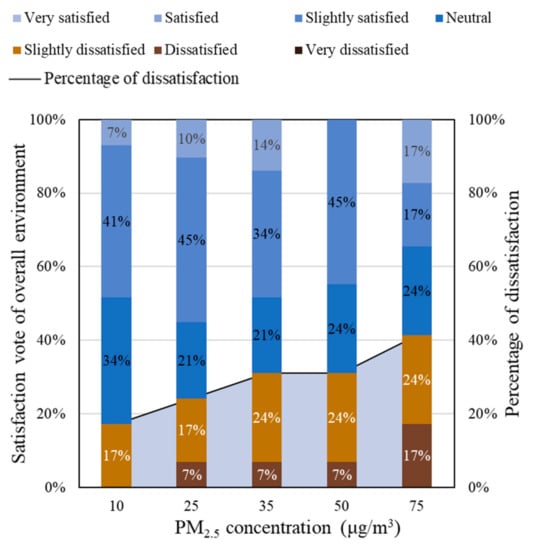
Figure 6.
Satisfaction vote and percentage of dissatisfaction of overall environment.
3.3. Satisfaction Vote of Air Quality under Different PM2.5 Concentrations
The mean values of the IAQ satisfaction votes () under the different PM2.5 concentrations for the votes for satisfaction are shown in Figure 7. Under the low CO2 concentration condition, IAQ satisfaction votes decreased from 0.34 to −0.27 when the PM2.5 concentration rise from 10 to 75 μg/m3. Under the high CO2 concentration condition, the IAQ satisfaction votes decreased from −0.03 to −1.41 within the range of the PM2.5 concentration from 10 to 75 μg/m3. The results of changes in IAQ satisfaction votes consistent with the results shown in Figure 5, that showing the significant effect of indoor PM2.5 concentration on occupant satisfaction. The effect is simultaneously exacerbated when combined with a high CO2 concentration.
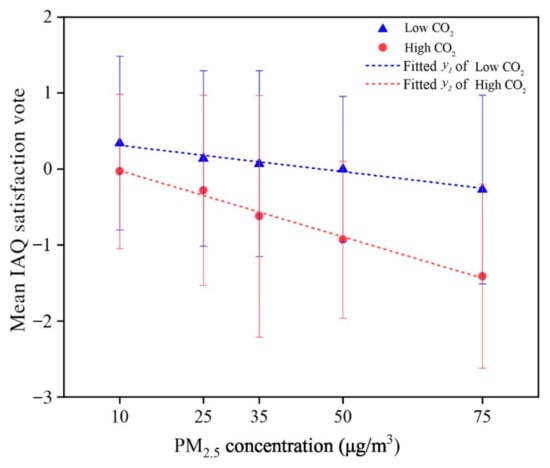
Figure 7.
The relationship between mean IAQ satisfaction vote and PM2.5 concentration.
The fitting lines of predicted mean IAQ satisfaction vote and PM2.5 concentration under two CO2 scenarios are expressed as follows:
For those cases with a low CO2 concentration (450–700 ppm):
For those cases with a high CO2 concentration (720–900 ppm):
where CPM2.5 is the PM2.5 concentration and is the predicted mean value of the IAQ satisfaction vote.
According to Equations (4) and (5), it was found that the mean IAQ satisfaction vote declines faster at a high CO2 concentration level (720–900 ppm) than at a low CO2 concentration level (450–700 ppm). In other words, the increase rate of dissatisfaction with PM2.5 is exaggerated by the higher CO2 concentration. More specifically, on condition of a low CO2 concentration (450–700 ppm), if the PM2.5 concentration is less than 50 μg/m3, the mean IAQ satisfaction vote is above zero; on the condition of a high CO2 concentration (720–900 ppm), the average satisfaction vote of the air quality is consistently below zero. Therefore, in order to achieve an IAQ satisfaction vote above zero, it is recommended that PM2.5 concentrations be maintained at 50 μg/m3 or less, while CO2 concentrations can be limited to 700 ppm or less.
4. Influence of PM2.5 and CO2 on Work Productivity
4.1. Work Productivity with Different PM2.5 and CO2 Concentration
The standardized performances of four tasks, obtained with Equation (2), are summarized in Table 8. According to the Shapiro–Wilk test, except for logical thinking when PM2.5 concentration was 10 μg/m3, all the data were normally distributed. The CO2 concentration influence was excluded from the two-way analysis of variance (ANOVA), leaving only the impact of the PM2.5 concentration, where the df is degree of freedom, F is the variance analysis results, ES is the effect size, and the p-value is the mean square.

Table 8.
Two-way analysis of variance (ANOVA) of four tasks performance (effect sizes of 0.01, 0.06, and 0.14 indicate small, moderate, and large effects).
Figure 8 shows that the trend of each task is different. According to Equation (2), 100% is the average level of each subject in productivity tests. There is no significant difference in understanding and memory or logical thinking. The standard deviations in logical thinking are less than 10%. These are much lower than for other tasks. A high CO2 concentration of 800 ppm can reduce occupant satisfaction (Figure 6), but no obvious evidence shows that it would influence the performance of understanding and memory or logical thinking, compared with that under the low CO2 concentration.
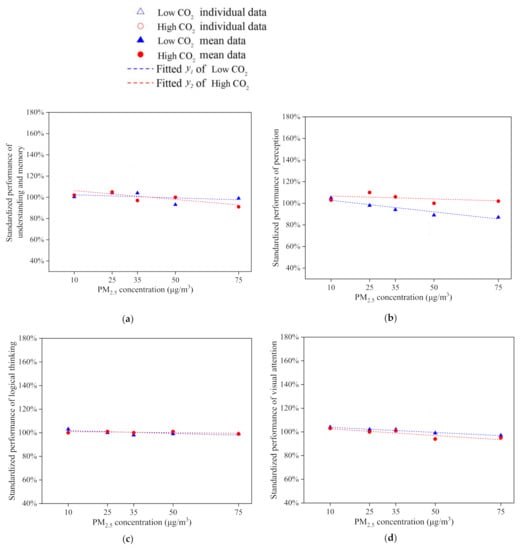
Figure 8.
Standardized performances of four productivity tests.
The p-value and the effect size were applied to identify the significance level and the difference between the different experimental conditions. The p-values for the task of perception were less than 0.05. ESs for perception were less than 0.06 but larger than 0.01. That explains why PM2.5 concentrations have a significant effect on the performance of understanding and memory, perception, and visual attention, as p < 0.05. The effect sizes are considered to be important as ES > 0.01. Combined with Figure 8, the performances of understanding, perception, and visual attention decreased as the PM2.5 concentration increased with the same level of CO2 concentration.
Especially in the visual attention task, the ES of PM2.5 concentration on visual attention is more than 0.06. Therefore, there is a moderate effect on visual attention. The performance standardized scores decreased from 104% to 96%, while the PM2.5 concentration increased from 10 to 75 μg/m3. This indicates that a high CO2 concentration reduces the visual attention. On the logical thinking task, the p-value is larger than 0.05, which means the decrease was not significant, but the effect size presented some practical importance for values greater than 0.01. The impact of the indoor PM2.5 concentration on mental work was thus verified.
4.2. Relative Performance under Different PM2.5 Concentrations
Many air quality experiments have been conducted to evaluate the impact of air pollution on performance change. Zivin and Neidell (2012) concluded that the impact of ozone on productivity is significant. A 10-ppb increase in ozone exposure directly leads to a 5.5% decrease of agricultural outcomes [47]. Adhvaryu et al. (2014) reported that an increase of 10 μg/m3 in air pollution leads to a reduction of 0.3% in worker efficiency in an Indian factory [48]. Chang et al. (2016) reported that productivity among fruit workers drops by 6% with a 10-unit increase in PM2.5 in California [49]. Another report from Chang showed that a 10-unit increase in the air pollution index (API) lowers the worker daily calls by 0.35% in China [50]. He et al. (2019) found that the effect of air pollution on labor productivity is subtle, and there is a 95% probability that every 10 μg/m3 in PM2.5 concentration causes a performance change from −0.4% to 0.1% [51].
The productivity of the participants under experimental condition was weighted with the relative performance (RPi,j) in Equation (3). The relationship between mean value of RP with different PM2.5 concentration is shown in Figure 9. In general, with an increase of PM2.5 concentration, the RP slightly decreases from 103% to 96%. The predicted mean value of the relative performance can be calculated by the least square method and the fitting relationship is as follows:
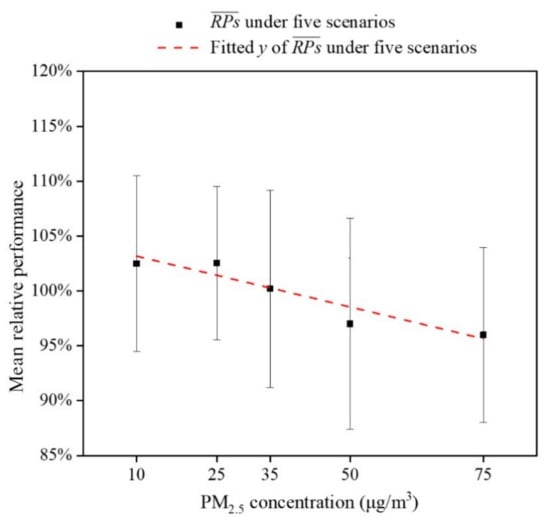
Figure 9.
Comparison of the quantitative relationship between relative performance and PM2.5 concentration.
For comparison, the ratio of the change in RP to the change in PM2.5 concentration is defined to estimate the effect of the PM2.5 concentrations on productivity, expressed as Equation (7):
where is the changes in the predicted mean value of the relative performance; is the changes in PM2.5 concentrations; is the ratio of the decrease in the productivity to the increase in the PM2.5 concentration.
The smaller the value (the greater the absolute value of a negative number), the greater the rate of decrease in the work productivity. According to previous experiments (Table 9 and Figure 10), Adhvaryu et al. [48] discussed the impact of the indoor PM2.5 concentration on the productivity in a garment factory, where the α value was −0.03%. Other two studies carried out in a Chinese call center and manufacturing firms shows the α value was −0.035% and [−0.04 to 0.01%]. The α value in this study was −0.10%, which was lower than these studies. Compared with these studies, this indicates that the mental work in offices tends to be more sensitive to PM2.5 pollution, while low-intensity workers tend to be more sensitive to PM2.5 pollution than high-intensity workers. Based on a study in a pear-packing factory in United States (α value = −0.6), it seems that workers in China and India have a higher tolerance towards PM2.5 pollution. This may be related to the environment that the workers have been in for a long time, where smaller changes in air quality in a better environment may cause a decrease in the productivity. Conversely, changes in air quality have relatively little impact on productivity as workers adapt to already poor environment.

Table 9.
Comparison of the rates of performance change in different studies.
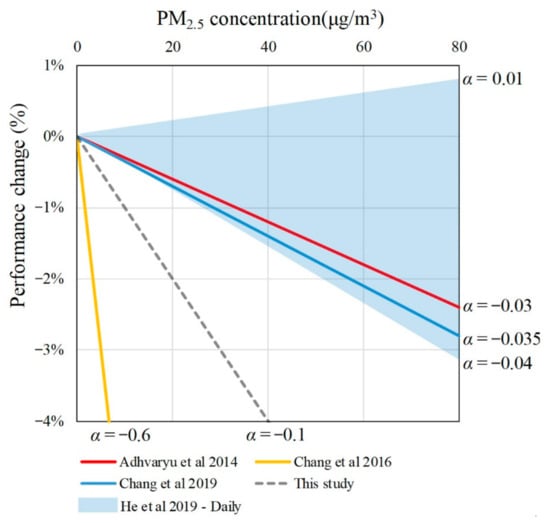
Figure 10.
Comparison of the relationship between PM2.5 concentration and performance change. Data sources: Adhvaryu et al. 2014 [48]; Chang et al. 2019 [50]; This study; Chang et al. 2016 [49]; He et al. 2019 [51].
4.3. Relationship between Air Quality Dissatisfaction and Performance Change
The relationship between the productivity of the participants and IAQ satisfaction under the different PM2.5 conditions was further analyzed. The Figure 11 shows the air quality dissatisfaction and performance change between this study and previous work. In this study, every 10% increase in the IAQ dissatisfaction would reduce the work productivity by 1.3% when the IAQ dissatisfaction value is lower than 40%. However, when the IAQ dissatisfaction increases over 40%, the downward trend of the work productivity is more pronounced. Every 10% increase in the IAQ dissatisfaction would reduce the work productivity by 1.5%, and this number would increase to 2.6% when the IAQ dissatisfaction value rises over 50%. This result was consistent with the trends observed in the previous works [23,52].
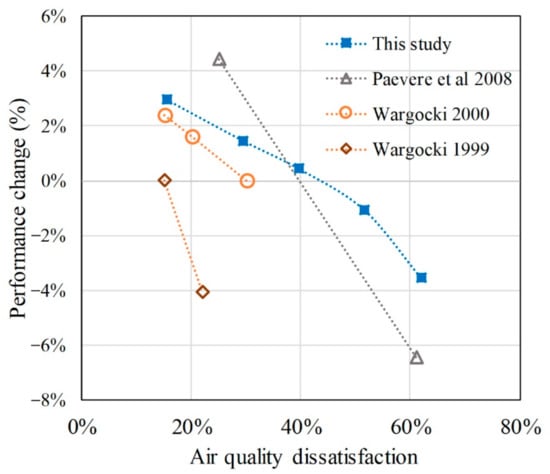
Figure 11.
Comparison of the relationship between air quality dissatisfaction and performance change. Data sources: [22]; Wargocki 2000 [23]; Paevere et al. 2008 [50].
The relative performance of the participants with the same number of satisfied votes is shown in Figure 12. The size of each circle represents the corresponding number of participants who voted for that degree of satisfaction. Most of air quality satisfaction votes ranged between −2 and 1, which means votes were between dissatisfied and slightly satisfied. A positive correlation can be observed between the mean value of RP and the satisfaction vote, while the fitting line expressed as Equation (8).
where is the mean value of the relative performance; is the participant IAQ satisfaction vote.
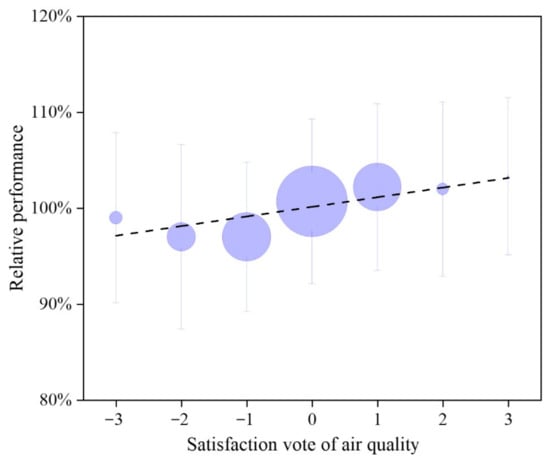
Figure 12.
The quantitative relationship between relative performance and satisfaction vote of air quality. The size of circle represents the corresponding sample size.
When the satisfaction vote is equal to or greater than zero, the predicted is more than 100%. Conversely, if the satisfaction vote is less than zero, the predicted is less than 100%. Considering the predicted mean IAQ satisfaction expressed in Equations (4) and (5), the indoor PM2.5 must be kept within 50 μg/m3 and the CO2 concentrations preferably limited to 700 ppm to improve the work productivity and the satisfaction in offices.
5. Conclusions
This study presents data from PM2.5 and CO2 exposure evaluations on occupant satisfaction and work productivity in a simulated meeting room. A quantitative model to assess work productivity was established, including focusing on understanding and memory, perception, logical thinking, and visual attention. The main conclusions are as follows:
- The results indicate that every 1 μg/m3 increment of indoor PM2.5 concentration (in the range of 10–75 μg/m3) would increase the dissatisfied rate by 0.5% at a low CO2 condition and 1.1% at a high CO2 condition. This impact is exacerbated when coupled with a high CO2 concentration, as every 1% increase in the air quality dissatisfaction would causes a 0.5% increase in the overall environment dissatisfaction.
- The impact of the high PM2.5 with CO2 concentrations on the participants performances in the four mental tasks was verified by statistical analysis. Every 10 μg/m3 increase in the PM2.5 concentration level can reduce the overall performance by 1%. The mental work tended to be more sensitive when compared with manual work.
- It is suggested to maintain the indoor PM2.5 within 50 and CO2 concentration at less than 700 ppm in order to improve the work productivity and occupant satisfaction for indoor air quality in offices.
The participants in this study were all college students, and the impact on people of different ages and physical conditions may be different. Because this relationship may vary based on the ventilation mode, room layouts, and participants, further experiments are needed.
Author Contributions
Conceptualization, J.W. (Jindong Wu), J.W. (Jiantao Wen) and B.X.; methodology, J.W. (Jindong Wu), J.W. (Jiantao Wen) and B.X.; formal analysis, J.W. (Jindong Wu) and J.W. (Jiantao Wen); investigation, J.W. (Jindong Wu) and Y.Z.; writing—original draft preparation, J.W.; writing—review and editing, J.W. (Jindong Wu), B.X. and Q.S. All authors have read and agreed to the published version of the manuscript.
Funding
This research was funded by the China National Key R&D Program, grant number 2016YFC0700100 (Institution Review Board of Zhejiang University 2020–004), the Zhejiang Provincial Natural Science Foundation, grant number LQ18E080002 and National Natural Science Foundation of China, grant number 51808486.
Institutional Review Board Statement
This research obtained approval from the Medical Academic Ethics Committee of Zhejiang University School of Medicine.
Informed Consent Statement
Informed consent was obtained from all subjects involved in the study.
Data Availability Statement
The data presented in this study are available on request from the corresponding authors. The data are not publicly available due to participants’ privacy.
Acknowledgments
We appreciate the support from all participants in this study.
Conflicts of Interest
The authors declare no conflict of interest.
Nomenclature
| CPM2.5 | Concentration of PM2.5 (μg/m3) |
| ES | Effect size |
| RP | Relative performance |
| SVAQ | Satisfaction vote of air quality |
| z | The scores and reciprocals of finish times |
| z′ | The standardized value of scores and reciprocals of finish times |
| α | Rate of performance change |
| β | The constants in different cases |
Appendix A
NO: ―――――― TIME: ――――――
Questionnaire Survey
- Background information
- (a)
- Name: ――――――
- (b)
- Gender: □ Male □ Female
- (c)
- Age: ――――――; Height: ――――――cm; Weight: ――――――kg
- Satisfaction survey I
| Very dissatisfied Neutral Very satisfied | |||||||
| −3 | −2 | −1 | 0 | 1 | 2 | 3 | |
| Indoor air quality | ○ | ○ | ○ | ○ | ○ | ○ | ○ |
| Outdoor air quality | ○ | ○ | ○ | ○ | ○ | ○ | ○ |
| Air temperature | ○ | ○ | ○ | ○ | ○ | ○ | ○ |
| Relative humidity | ○ | ○ | ○ | ○ | ○ | ○ | ○ |
| Lighting | ○ | ○ | ○ | ○ | ○ | ○ | ○ |
| Acoustic | ○ | ○ | ○ | ○ | ○ | ○ | ○ |
| Overall environment | ○ | ○ | ○ | ○ | ○ | ○ | ○ |
- 3.
- IAQ Satisfaction survey II
| Very dissatisfied Neutral Very satisfied | |||||||
| −3 | −2 | −1 | 0 | 1 | 2 | 3 | |
| Indoor air quality | ○ | ○ | ○ | ○ | ○ | ○ | ○ |
References
- Klepeis, N.E.; Nelson, W.C.; Ott, W.R.; Robinson, J.P.; Tsang, A.M.; Switzer, P.; Behar, J.V.; Hern, S.C.; Engelmann, W.H. The National Human Activity Pattern Survey (NHAPS): A resource for assessing exposure to environmental pollutants. J. Expo. Anal. Environ. Epidemiol. 2001, 11, 231–252. [Google Scholar] [CrossRef] [PubMed]
- Duan, X.; Zhao, X.; Wang, B.; Chen, Y.; Cao, S. Highlights of the Chinese Exposure Factors Handbook (Adults); Elsevier: London, UK, 2015. [Google Scholar] [CrossRef]
- Jensen, K.L.; Toftum, J.; Friis-Hansen, P. A Bayesian Network approach to the evaluation of building design and its consequences for employee performance and operational costs. Build. Environ. 2009, 44, 456–462. [Google Scholar] [CrossRef]
- MacNaughton, P.; Pegues, J.; Satish, U.; Santanam, S.; Spengler, J.; Allen, J. Economic, environmental and health implications of enhanced ventilation in office buildings. Int. J. Environ. Res. Public Health 2015, 12, 14709–14722. [Google Scholar] [CrossRef] [PubMed]
- Wyon, D.P. Indoor environmental effects on productivity. In Proceedings of the IAQ, Baltimore, MD, USA, 6–8 October 1996; pp. 5–15. [Google Scholar]
- Toftum, J.; Reimann, G.; Foldbjerg, P.; Clausen, G.; Fanger, P.O. Perceived air quality, thermal comfort, and SBS symptoms at low air temperature and increased radiant temperature. In Proceedings of the 9th International Conference on Indoor Air Quality and Climate, Monterey, CA, USA, 30 June–5 July 2002; pp. 267–272. [Google Scholar]
- Seppänen, O.; Fisk, W.J.; Lei, Q.H. Room temperature and productivity in office work. In Proceedings of the Healthy Buildings 2006 Conference, Lisbon, Portugal, 4–8 June 2006. [Google Scholar]
- Wong, L.T.; Mui, K.W.; Hui, P.S. A multivariate-logistic model for acceptance of indoor environmental quality (IEQ) in offices. Build. Environ. 2008, 43, 1–6. [Google Scholar] [CrossRef]
- Lan, L.; Wargocki, P.; Lian, Z. Quantitative measurement of productivity loss due to thermal discomfort. Energy Build. 2011, 43, 1057–1062. [Google Scholar] [CrossRef]
- Wang, D.; Xu, Y.; Liu, Y.; Wang, Y.; Jiang, J.; Wang, X.; Liu, J. Experimental investigation of the effect of indoor air temperature on students’ learning performance under the summer conditions in China. Build. Environ. 2018, 140, 140–152. [Google Scholar] [CrossRef]
- Geng, Y.; Ji, W.; Lin, B.; Zhu, Y. The impact of thermal environment on occupant IEQ perception and productivity. Build. Environ. 2017, 121, 158–167. [Google Scholar] [CrossRef]
- Al Horr, Y.; Arif, M.; Kaushik, A.; Mazroei, A.; Katafygiotou, M.; Elsarrag, E. Occupant productivity and office indoor environment quality: A review of the literature. Build. Environ. 2016, 105, 369–389. [Google Scholar] [CrossRef]
- Dockery, D.W.; Arden Pope, C.; Xu, X.; Spengler, J.D.; Ware, J.H.; Fay, M.E.; Ferris, B.G., Jr.; Speizer, F.E. An association between air pollution and mortality in six US Cities. N. Engl. J. Med. 1993, 329, 1753–1759. [Google Scholar] [CrossRef]
- Zhou, Z.; Liu, Y.; Yuan, J.; Zuo, J.; Chen, G.; Xu, L.; Rameezdeen, R. Indoor PM2.5 concentrations in residential buildings during a severely polluted winter: A case study in Tianjin, China. Renew. Sustain. Energy Rev. 2016, 64, 372–381. [Google Scholar] [CrossRef]
- Xia, T.; Chen, C. Differentiating between indoor exposure to PM2.5 of indoor and outdoor origin using time-resolved monitoring data. Build. Environ. 2017, 147, 528–539. [Google Scholar] [CrossRef]
- Du, Y.; Wang, Y.; Du, Z.; Zhang, Y.; Xu, D.; Li, T. Modeling of residential indoor PM2.5 exposure in 37 counties in China. Environ. Pollut. 2018, 238, 691–697. [Google Scholar] [CrossRef]
- Chamseddine, A.; Alameddine, I.; Hatzopoulou, M.; El-Fadel, M. Seasonal variation of air quality in hospitals with indoor–outdoor correlations. Build. Environ. 2019, 148, 689–700. [Google Scholar] [CrossRef]
- Persily, A.K. Evaluating building IAQ and ventilation with indoor carbon dioxide. ASHRAE Trans. 1997, 103, 193–203. [Google Scholar]
- Intergovernmental Panel on Climate Change. Contribution of Working Groups I, II and III to the Fifth Assessment Report of the Intergovernmental Panel on Climate Change. In Climate Change 2014: Synthesis Report; IPCC: Geneva, Switzerland, 2014. [Google Scholar]
- Janssen, J. Ventilation for Acceptable Indoor Air Quality. ASHRAE J. 1989, 31, 40–42. [Google Scholar]
- Petty, S. Summary of ASHRAE’s Position on Carbon Dioxide (CO2) Levels in Spaces. 2014. Available online: http://www.eesinc.cc/downloads/CO2positionpaper.pdf (accessed on 28 January 2020).
- Wargocki, P.; Wyon, D.P.; Baik, Y.K.; Clausen, G.; Fanger, P.O. Perceived air quality, sick building syndrome (SBS) symptoms and productivity in an office with two different pollution loads. Indoor Air. 1999, 9, 165–179. [Google Scholar] [CrossRef]
- Wargocki, P.; Wyon, D.P.; Fanger, P.O. Productivity is affected by the air quality in offices. In Proceedings of the Healthy Buildings 2000, Helsinki, Finland, 10–14 June 2000; pp. 635–640. [Google Scholar]
- Wyon, D.P. The effects of indoor air quality on performance and productivity. Indoor Air. 2004, 14, 92–101. [Google Scholar] [CrossRef]
- Mui, K.W.; Wong, L.T.; Hui, P.S.; Chan, W.Y. Formaldehyde exposure risk in air-conditioned offices of Hong Kong. Build. Serv. Eng. Res. Technol. 2009, 30, 279–286. [Google Scholar] [CrossRef]
- Satish, U.; Mendell, M.J.; Shekhar, K.; Hotchi, T.; Sullivan, D. Concentrations on Human Decision-Making Performance. Environ. Health Perspect. 2012, 120, 1671–1678. [Google Scholar] [CrossRef]
- Vehviläinen, T.; Lindholm, H.; Rintamäki, H.; Pääkkönen, R.; Hirvonen, A.; Niemi, O.; Vinha, J. High indoor CO2 concentrations in an office environment increases the transcutaneous CO2 level and sleepiness during cognitive work. J. Occup. Environ. Hyg. 2016, 13, 19–29. [Google Scholar] [CrossRef]
- Allen, J.G.; MacNaughton, P.; Satish, U.; Santanam, S.; Vallarino, J.; Spengler, J.D. Associations of cognitive function scores with carbon dioxide, ventilation, and volatile organic compound exposures in office workers: A controlled exposure study of green and conventional office environments. Environ. Health Perspect. 2016, 124, 805–812. [Google Scholar] [CrossRef] [PubMed]
- Ministry of Housing and Urban-Rural Development of the People’s Republic of China. Standard for Lighting Design of Buildings/GB 50034-2013; China Architecture Publishing & Media Co., Ltd.: Beijing, China, 2014. [Google Scholar]
- World Health Organization. WHO Air Quality Guidelines for Particulate Matter, Ozone, Nitrogen Dioxide and Sulfur Dioxide: Global Update 2005: Summary of Risk Assessment. 2005. Available online: http://www.who.int/iris/handle/10665/69477 (accessed on 10 February 2020).
- Ministry of Ecology and Environment of the People’s Republic of China. Ambient Air Quality Standards GB 3095-2012; China Environmental Press: Beijing, China, 2012. [Google Scholar]
- Cui, X.; Li, F.; Xiang, J.; Fang, L.; Chung, M.K.; Day, D.B.; Mo, J.; Weschler, C.J.; Gong, J.; He, L.; et al. Cardiopulmonary effects of overnight indoor air filtration in healthy non-smoking adults: A double-blind randomized crossover study. Environ. Int. 2018, 114, 27–36. [Google Scholar] [CrossRef] [PubMed]
- Flegal, K.M.; Shepherd, J.A.; Looker, A.C.; Graubard, B.I.; Borrud, L.G.; Ogden, C.L.; Harris, T.B.; Everhart, J.E.; Schenker, N. Comparisons of percentage body fat, body mass index, waist circumference, and waist-stature ratio in adults. Am. J. Clin. Nutr. 2009, 89, 500–508. [Google Scholar] [CrossRef] [PubMed]
- World Health Organization. Global Health Observatory data Tuberculosis, WHO. 2017. Available online: https://www.who.int/gho/ncd/risk_factors/bmi_text/en/ (accessed on 9 December 2019).
- Liu, H.; Liao, J.; Yang, D.; Du, X.; Hu, P.; Yang, Y.; Li, B. The response of human thermal perception and skin temperature to step-change transient thermal environments. Build. Environ. 2014, 73, 232–238. [Google Scholar] [CrossRef]
- Sanni-Anibire, M.O.; Hassanain, M.A. Quality assessment of student housing facilities through post-occupancy evaluation. Archit. Eng. Des. Manag. 2016, 12, 367–380. [Google Scholar] [CrossRef]
- Huizenga, C.; Zagreus, L.; Arens, E.; Lehrer, D. Measuring indoor environmental quality: A web-based occupant satisfaction survey. In Proceedings of the Greenbuild 2003, Pittsburgh, PA, USA, 1–3 November 2003; pp. 1–9. [Google Scholar]
- Barsalou, L.W. Cognitive Psychology an Overview for Cognitive Scientists, 1st ed.; Psychology Press: New York, NY, USA, 1992. [Google Scholar] [CrossRef]
- Poremba, A. Neural and behavioral correlates of auditory short-term and recognition memory. In Mechanisms of Sensory Working Memory; Elsevier Inc.: Amsterdam, The Netherlands, 2015; pp. 187–200. [Google Scholar] [CrossRef]
- Stroop, J.R. Studies of interference in serial verbal reactions. J. Exp. Psychol. 1935, 18, 643–662. [Google Scholar] [CrossRef]
- Kagan, J.; Pearson, L. and Lois Welch, Conceptual Impulsivity and Inductive Reasoning. Child Dev. 1966, 37, 583–594. [Google Scholar] [CrossRef]
- Game Clicker or Schulte Tables. Rules and Information about the Game. Available online: https://brainapps.io/game/Clicker (accessed on 31 January 2020).
- Lund, A. Adaptive Attention—Challenge Adjusting Application for Sustained Attention. 2014. Available online: https://projekter.aau.dk/projekter/files/201270844/Report.pdf (accessed on 31 January 2020).
- Shapiro, S.S.; Wilk, M.B. An analysis of variance test for normality (complete samples). Biometrika 1968, 52, 591–611. [Google Scholar] [CrossRef]
- Kelley, K.; Preacher, K.J. On effect size. Psychol. Methods 2012, 17, 137–152. [Google Scholar] [CrossRef]
- Miles, J.; Shevlin, M. Applying Regression and Correlation: A Guide for Students and Researchers, 1st ed.; Sage Publications Ltd.: London, UK, 2000. [Google Scholar]
- Zivin, J.G.; Neidell, M. The impact of pollution on worker productivity. Am. Econ. Rev. 2012, 102, 3652–3673. [Google Scholar] [CrossRef]
- Adhvaryu, A.; Kala, N.; Nyshadham, A. Management and Shocks to Worker Productivity: Evidence from Air Pollution Exposure in an Indian Garment. 2014. Available online: https://economics.sas.upenn.edu/sites/default/files/filevault/event_papers/nyshadham_JMP.pdf (accessed on 16 February 2020).
- Chang, T.; Zivin, J.G.; Gross, T.; Neidell, M. Particulate pollution and the productivity of pear packers. Am. Econ. J. Econ. Policy 2016, 8, 141–169. [Google Scholar] [CrossRef]
- Chang, T.Y.; Zivin, J.G.; Gross, T.; Neidell, M. The effect of pollution on worker productivity: Evidence from call center workers in China. Soc. Sci. Electron. Publ. 2019, 11, 151–172. [Google Scholar] [CrossRef]
- He, J.; Liu, H.; Salvo, A. Severe air pollution and labor productivity: Evidence from industrial towns in China. Am. Econ. J. Appl. Econ. 2019, 11, 173–201. [Google Scholar] [CrossRef]
- Paevere, P.; Brown, S.; Leaman, A.; Luther, M.; Adams, R. Indoor environment quality and occupant productivity in the CH2 building. In Proceedings of the 2008 International Scientific Committee World Sustainable Building Conference, Melbourne, Australia, 21–25 September 2008; pp. 222–229. [Google Scholar]
Publisher’s Note: MDPI stays neutral with regard to jurisdictional claims in published maps and institutional affiliations. |
© 2021 by the authors. Licensee MDPI, Basel, Switzerland. This article is an open access article distributed under the terms and conditions of the Creative Commons Attribution (CC BY) license (https://creativecommons.org/licenses/by/4.0/).